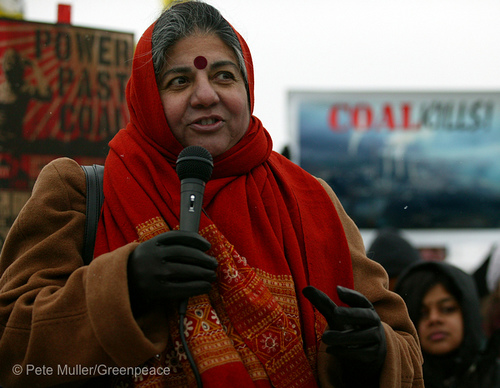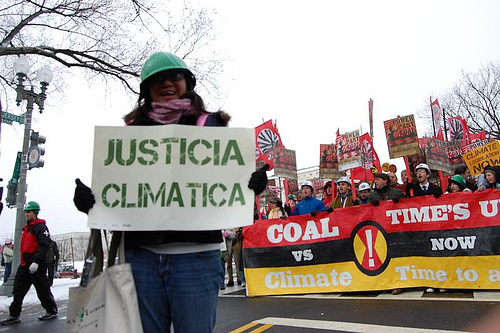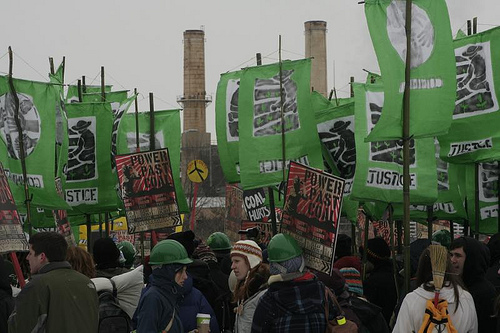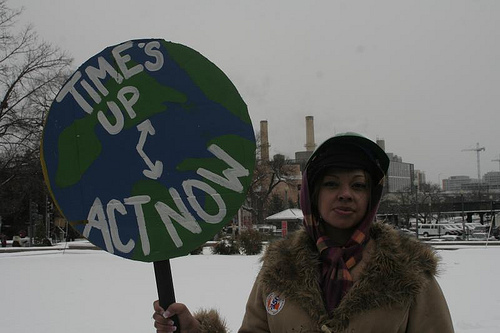
About a month or so after the Capitol Climate action I wrote a movement strategy piece to reflect on its lessons. It is the cover story for the May issue of Z Magazine and pasted below. This magazine came out on the day we heard from the Administration that they have begun to implement their promise to phase coal out of the Capitol Power Plant.
Climate Justice and Coal’s Funeral Procession
Learning from the Capitol Climate Action
The snow was 4.5 inches deep and it was 23 degrees out when our action started at 1pm. We could already hear the Fox News commentators making the usual absurd statements: “A global warming protest in the snow?! Maybe this climate change stuff isn’t real after all, ha ha ha.” But by the end of the day, even Fox News gave positive coverage to the largest protest in history demanding solutions to the climate crisis.
On March 2nd, around 4,000 people came to the Capitol Power Plant in Washington DC, over 2,000 of whom risked arrest through civil disobedience. The vast majority had never been to a demonstration of any kind before, let alone engaged in non-violent direct action. People from communities most directly impacted by coal’s lifecycle — from Navajo reservations in the Southwest to Appalachian towns in the Southeast — led the march. With vibrant multicolored flags depicting windmills, people planting gardens, waves crashing, and captions like “community,” “security,” “change” and “power,” we sat-in to blockade five entrances to the power plant that literally fuels Congress. We called the whole thing the “Capitol Climate Action” (CCA).
The belching smoke stacks just two blocks from the Capitol building made a fitting target for a national flashpoint. They symbolize the stranglehold that the dirty fossil fuel industry – and coal industry in particular – has on our government, economy, and future. Burning coal is the single biggest contributor to global warming. We will not be able to solve the climate crisis or build a clean energy economy without breaking its hold.
 Notable people of all kinds joined our demonstration, legitimizing the tactic of civil disobedience for a mainstream audience. From the scientific community, Dr. James Hansen (the world’s foremost climatologist) and Gus Speth (former environment advisor to Jimmy Carter) risked arrest. Writers like Wendell Berry joined them. Environmental advocates like Dr. Vandana Shiva and Bill McKibben, religious leaders of all stripes, DC’s Congresswoman Eleanor Holmes Norton, and celebrities such as Daryl Hannah participated.
Notable people of all kinds joined our demonstration, legitimizing the tactic of civil disobedience for a mainstream audience. From the scientific community, Dr. James Hansen (the world’s foremost climatologist) and Gus Speth (former environment advisor to Jimmy Carter) risked arrest. Writers like Wendell Berry joined them. Environmental advocates like Dr. Vandana Shiva and Bill McKibben, religious leaders of all stripes, DC’s Congresswoman Eleanor Holmes Norton, and celebrities such as Daryl Hannah participated.
At the end of the day it was clear that the police had been overwhelmed by our numbers and were not going to arrest anyone unless we escalated to felony charges, which we were unwilling to do (though the image of Dr. Hansen scaling a fence is pretty romantic). Instead, we declared victory after shutting the plant down for the afternoon. Thousands of us exited on our own terms and committed to use the experience to build our local movements stronger in what has become a defining year for the climate.

We cannot win the battle on climate change without immediate, binding, science-based federal legislation. 2009 is crucial, and not just because of the terrifying tipping points that scientists describe. It’s our year because the political window to pass this legislation is growing increasingly urgent as we march toward the United Nations climate talks in Copenhagen this December. In the U.S., the fossil fuel industry employs over 2,340 corporate lobbyists and is throwing over $90 million at pushing false solutions (nuclear, “clean” coal, industrial agrofuels, and others) that devastate communities. In response, people’s movements need to create political space for progressives in office to write bolder policy (and push them do to so) in the short and mid-term. For the long-term, we need to continue to build community-based solutions, like wind farms, urban gardens, and other projects that localize our economies. This calls for an aligned “inside / outside” movement strategy that honors the different roles that a broad spectrum of organizations, networks, and activists must take.
CCA sought to anchor an outside action-arm of this spectrum. The role of such an anchor is to help shift the center of political conversation in the U.S. further to the left. This must happen within the context of building the broad-based progressive majoritarian coalition currently coalescing in the United States, offering a holistic narrative and program of solutions to intersecting crises (ecological, economic, political etc).
The mistakes and successes of CCA are instructive for building a movement that is both broad-based and politically savvy, as well as bold in demanding genuine solutions. Evaluations of actions like CCA must always be measured against this objective.
Context
The pace of direct actions against coal has sharply increased since 2004. These campaigns have been organized and carried out by a polycentric global network of student organizers, “frontline” communities (those most directly affected by injustice), radical environmentalists, and traditional non-profits. In the United States, communities have been using non-violent direct action to confront coal at all stages of its lifecycle (finance, extraction, “cleaning” and transport, burning, and energy consumption). This trajectory began gaining momentum on November 10, 2004 with a blockade of Maryland’s Dickerson Power Plant, grew to three major direct actions in 2005, two more in 2006, six in 2007, shot up to 18 actions in 2008, and 15 actions within the first two and a half months of 2009 alone.
Similar to the Anti-Nuclear movement of the late 1970s and early 1980s, the Anti-Coal movement has targeted specific mines and plants while challenging the overall legitimacy of fossil-fuel-based economies.
We organized the Capitol Climate Action because we saw an opening to connect these struggles more publicly, help build momentum around them, and “supercharge” the energy to keep the exponential increase rising.
This struggle has transcended single-issue organizing. The varied efforts to stop coal have brought diverse stakeholders together. Stemming from the people of color, working class, and women-led Environmental Justice movement, Climate Justice has become a political banner for the climate crisis’ intersecting racial justice, economic equity, community health, and environmental quality issues, of which elements of “no coal struggles” are a part. It is useful to think of campaigns against coal as one strand of a robust frontline-led Climate Justice movement.

At CCA, marginalized communities impacted by mountain-top removal mining in Appalachia mobilized their bases to travel to DC. Indigenous communities resisting strip mining and resource theft from the Southwest United States and from Canada joined them. Folks suffering from asthma and pollution caused by coal-burning plants in the inner city also played a role, and were joined and supported by thousands of other folks (primarily white youth and students, but also religious congregations, families, teachers, and others) new to this movement.
Organizers from four national/regional non-profit organizations (Greenpeace, Rainforest Action Network, Chesapeake Climate Action Network, and the Ruckus Society) comprised the CCA organizing core. These were not community-based organizations, but rather sought to act in solidarity with frontline groups. CCA organizers consulted such communities throughout the build-up, and we invited these groups to lead the march and become spokespeople for the action.
CCA Goals and Outcomes
We had three “big picture” goals with the Capitol Climate Action:
1) Change the national conversation on climate.
We wanted to get sympathetic mainstream media coverage, with a climate justice framework that highlighted coal as a driver of global warming. Within a single media cycle, we had positive pieces in the Associated Press (AP), TIME Magazine, CNN, USA Today, New York Times blogs, Democracy Now!, The Nation, and a host of others. The action generated over 700 media stories.
We wanted the message to be specific enough to be impactful (no more coal!), but also solution-oriented and visionary. Great care was taken to make sure the media reflected concerns ranging from public health to economic sustainability, weaving them together to make a political statement that was quite radical. While media outlets ignored the specifics around “2009 climate policy”, the general receptiveness of media to our broader message reflects an opportunity to continue to build and shape a new progressive narrative around climate and the economy.
2) Press the new administration and Congress for bolder climate policy in 2009.
This “mid-term” goal is difficult to evaluate just a month after the action, but we are already seeing indications of some success. Three days before our action, Speaker of the House Nancy Pelosi and Senate Majority Leader Harry Reid announced that the Capitol Power Plant would be “greened” by switching from coal to natural gas. Our action objectives went well beyond this specific plant, and natural gas is certainly not the solution (it’s an industry-backed false solution), but it’s a meaningful step forward that was clearly the direct result of the threat of protest. While Pelosi’s move seemed aimed at taking the wind out of our sails, it had the opposite effect, publicly validating the power and efficacy of grassroots popular pressure. It demonstrated that people-power can open the political window we have with a new Congress and administration…and that we need to push harder.
We timed our action within the “first 100 days” of the new administration to communicate that regular people are offering leadership and not waiting around to have change legislated for them. More specifically, CCA coincided with the largest lobby day on climate in history. Thousands of young people who attended the Power Shift 09 youth summit on the climate crisis (occurring that same weekend) demanded clean energy policy inside Congress. Various reasons prevented us from working explicitly with the Power Shift conference to have a publicly unified approach, which was a missed opportunity to integrate strategies and do thorough political education with participants about the value of outside friction creating inside momentum.
3) Build the climate justice movement and legitimize non-violent direct action and civil disobedience.
We believe that we will solve the intersecting crises of our time through a mass movement of millions. As such we must to be relevant to, and help build our “anchor” as part of, our country’s progressive majority. We therefore did not focus on mobilizing seasoned activists. We primarily engaged “passive allies” – people who care about the issue but have not yet taken action. We wanted CCA to be a vehicle through which new people had a transformational first experience and joined the movement.
The breadth of endorsing organizations is one indicator of success. More than 100 groups publicly endorsed the action, ranging from public health organizations, religious groups, and clean-energy businesses, to grassroots environmental networks, labor groups, and racial justice organizations. These groups helped mobilize a base of mostly first-time activists, (many of whom also came from Power Shift) who participated in a build-up that trained more than 2,000 people in civil disobedience, growing the capacity of our movement.
We also measure success by how well this action served to “supercharge” the movement against coal across the country. Three days after the CCA, there was another civil disobedience action at Coal River Mountain in West Virginia. Six days later there was a mass-action in Belgium blockading EU Finance Ministers, with over 350 arrests, citing CCA as a big inspiration for their recruitment. On March 14, there was an action in Knoxville protesting the Tennessee Valley Authority around the recent coal ash sludge spill. The Same day, 80 activists inspired by CCA marched in Palm Springs, CA as part of the Power Past Coal campaign. Three CCA inspired actions happened that week in Massachusetts. Decentralized “Fossil Fools Day” actions targeting coal happened across the continent on April 1. On April 20, there is a mass-action called the “Cliffside Climate Action” in North Carolina to stop Duke Energy’s proposed coal plant.
Manufacturing Victory? Arrest and Escalation.
CCA navigated new challenges: we wanted to be good organizers and “meet people where they were at” – which meant “baby steps” for brand new folks. After CCA, some of the more seasoned activists critiqued that we did too much controlled hand-holding of new activists and should have escalated further.

We likely could not have escalated this action without some incurring felony charges and potentially endangering others unprepared for it. While escalating to achieve some arrests may have attracted more media attention, it is likely it would have been lower quality. Such coverage would likely focus on a handful of arrests rather than 4,000+ courageous people braving the freezing cold in an unpermitted march and illegal action. Regardless, participant expectations lost alignment at the exit: depending on one’s perception of action goals, this move was either strategic, or a fabricated victory declaration.
A “decision dilemma” is a direct action term that refers to a certain kind of escalation. It means that we create a situation, through non-violent action, where the target is forced to either negotiate with the activists, or react with force (including arrests). Mistake number one was that CCA lacked a real decision dilemma from the beginning, putting us in a difficult spot on the day-of. The lack of demands around this specific plant (and defaulting to national policy-related demands being advanced by the students lobbying that day) undercut the possibility for one. There was no specific response we were demanding on that day, other than the prevention of movement in and out of the plant. In freezing weather and police who were determined to wait us out, we had no tricks up our sleeve. We made the right decision for our circumstance, though questions about whether we could (or should) have shaped the action differently beforehand are valid.
Tactical circumstances (blizzards and all) aside, escalation must be in service of larger movement strategy – would pushing harder have been a service to the goal of bringing along the general public and pulling the conversation further left? Perhaps.
There are two kinds of direct action: “instrumental” and “expressive.”
Expressive actions communicate an idea. They are like a big exclamation point. They help shape popular discourse by influencing public debate. In these kinds of actions, arrests can help raise a profile, attract attention, and can give activists a moral higher ground. They can also, however, marginalize change-agents and distract from core messages, instead focusing on the tactic rather than the issue. Context is important.
Instrumental actions have an immediate concrete goal, directly stopping something from happening (for example, blockading a port deploying weapons to Iraq). In such actions, arrests are not the goal, but often an unfortunate byproduct. As friends have humorously noted, in any struggle throughout history, getting captured is usually seen as a bad thing.
The Capitol Climate Action was a mix of both of these things, leading to differences in perspective among participants about the role of arrests, and a lack of clarity about the utility of focusing on this specific plant, versus the stated symbolic action objectives. This action was an opportunity for us to flex our muscle; it served as a great “gateway,” though it didn’t fully test our limits.
Ninjas playing Chess
While there were over 100 organizations endorsing CCA, the core organizing was convened by four non-profits. The resources and time from these groups helped this action be detail-oriented and well coordinated. The front-line community groups we consulted said they did not have the capacity to help in the organizing, but requested input on the message as well as clear roles up-front in the action itself. Tactical decisions were made on-the-ground by a group of folks prioritizing safety of the group, empowering participants, and getting wide media coverage. Toward that end, we encouraged participants to form affinity groups (small groups of people who support one another). Unlike mass-actions of the Global Justice movement era, these affinity groups did not have decision-making power during the action itself. This organizational model was appropriate for the goals of this particular action, though there is still a crucial role for mass-actions that are rooted in street-level democracy and horizontal decision-making. As a symbolic action, CCA sought to stoke the wildfire of local instrumental actions across the country against the coal industry. Such instrumental actions must be community-led and part of ongoing strategic campaigns.
If we hope to have a sophisticated action-arm of a broader progressive coalition we must be precise about the roles of different organizing models as well as the roles of various organizations within them: “insider” non-profits who have a seat at the government table, direct-action-oriented non-profits, radical grassroots networks, community-based organizations, frontline communities, progressive politicians and green business.
Those of us who play the outside game must increasingly learn to be like ninjas – using exactly as much force as required to reach our objectives, but not more. We must be surgical in our interventions and have a strategic plan for how it helps shape the inside game. As such, movement strategy looks a lot more like a game of chess than one of checkers. Checkers are black and white (or black and red, as it were), and lend themselves to homogenous plowing forward without forethought. Chess is not just a game of strategy, but one that has a team of players each with differentiated roles and abilities. This is our current political moment.
Moving forward
Our political landscape is shifting, as is the nature of the “environmental” movement. Three out of the four White House environmental “heavy hitters” are people of color. Environmental leaders with racial justice organizing backgrounds like Van Jones are becoming Obama’s advisors. This signals a meaningful opening.
Until now, struggles against the coal industry have primarily centered on preventing the construction of new coal-burning plants. We now need to go after existing coal plants across the country. Here, lessons from the Anti-Nuclear movement are instructive. Direct actions at plants across the country did not decommission individual nuclear facilities, but cumulatively helped create moratorium on nuclear plant construction that lasted decades.
The seeds are planted for decentralized actions against coal across the United States, integrated with varied campaigning tactics on multiple fronts. Should we be successful at networking efforts, this network must weave itself into a broader Climate Justice movement (whether or not it uses that name). If we hope to win, the movement must be relevant enough to relate to, and help create, a broad-based progressive majority that is unafraid to build unlikely alliances across the political spectrum, while maintaining a principled anchor of its left wing.
Groups helping anchor the left wing of this formation are tying conditions to participation. These conditions currently center around economic empowerment and social uplift for communities of color and other impacted peoples, led by a compelling, if potentially co-opt-able, call for green jobs. Climate Justice organizers can build their leverage in this new political terrain through increased demonstrations of power. The Capitol Climate Action sought to test our limits, and found that we’re ready for more. So let’s push further.
For photos, video, and other multimedia from the Capitol Climate Action, see www.capitolclimateaction.org.
Joshua Kahn Russell is the Grassroots Actions Manager at Rainforest Action Network and was a lead organizer on the Capitol Climate Action.
